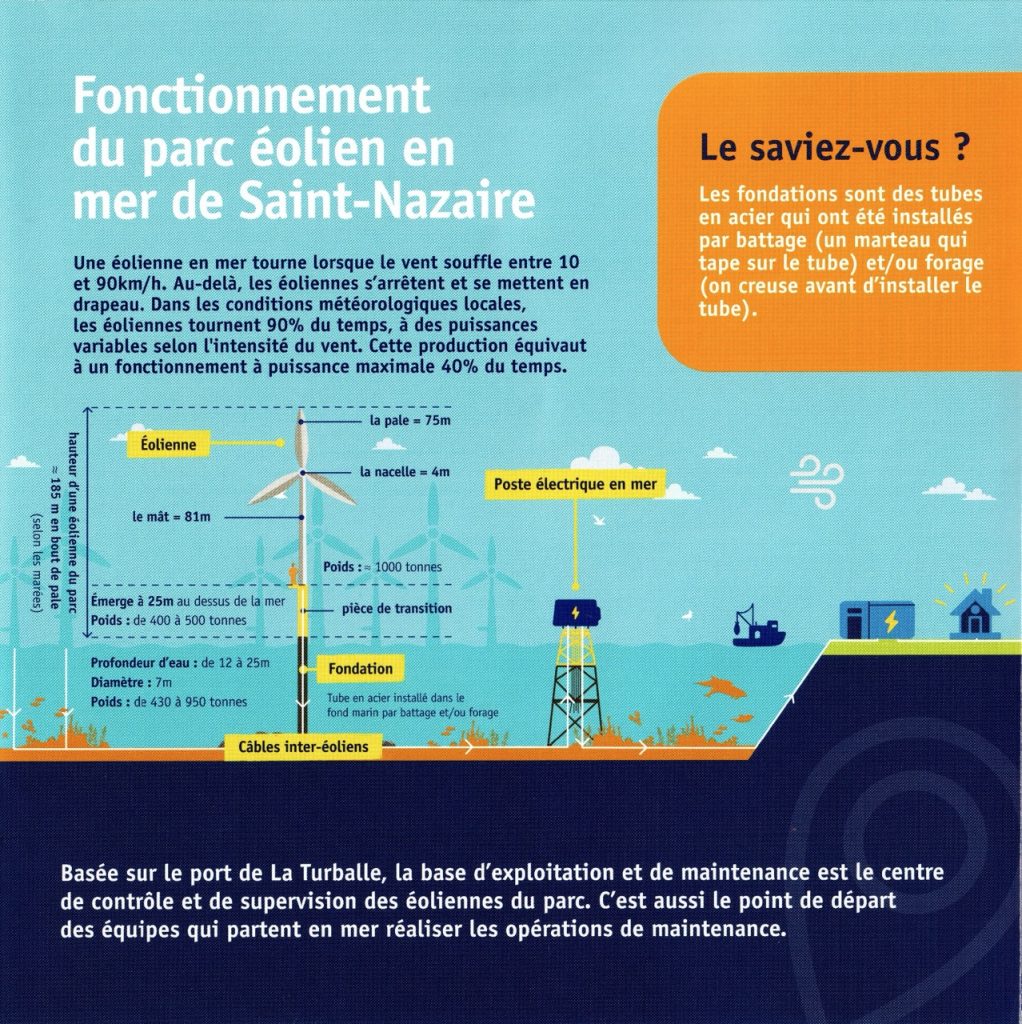
Last Tuesday, August 12th, I had the opportunity to go behind the scenes of France’s first offshore wind farm. After signing up through the “Visiter EDF” program website, I went to the Saint-Nazaire offshore wind farm’s maintenance base, located at the port of La Turballe, for a one-and-a-half-hour visit, from 2:00 PM to 3:30 PM.
The agenda was as simple as it was fascinating: first, a detailed presentation in the conference room, followed by a guided tour of the facilities that serve as the brain and starting point for all offshore operations.
This visit was an opportunity to gather an impressive amount of information about this titanic project. Here is a complete summary of everything I learned, to share the secrets of this sea giant with you.
The Saint-Nazaire Offshore Wind Farm: The Full Story
1. An Ambitious Energy Context
While countries like Denmark have been harnessing offshore wind energy for over 20 years, France is just beginning its race against time. The government’s goal is to develop 50 offshore wind farms by 2050. This ambitious target faces the complexity of regulations: the Saint-Nazaire park took 10 years to become operational, including 7 years dedicated solely to administrative procedures (impact studies, public consultations, permits) and about two and a half years for industrial construction. To speed things up, the government is relying on initiatives like “La mer en débat” (“The Sea in Debate”), which aims to conduct comprehensive environmental studies by coastline to simplify future projects.
2. The Saint-Nazaire Park: Fact Sheet
- Power and Composition: 80 wind turbines of 6 MW each, for a total capacity of 480 MW.
- Dimensions: The park covers an area of 78 km2, 12 km off the coast of the Guérande Peninsula.
- Production: It covers the electricity needs of 700,000 people, representing 20% of the Loire-Atlantique department’s consumption.
- Investment and Ownership: The project cost €2 billion. It is 50% owned by EDF Renewables and 50% by a consortium of Canadian financial partners, Enbridge and CPP Investments.
3. A Strategic Location: The Banc de Guérande

The site’s selection is the result of a rigorous analysis. The Banc de Guérande is a raised rocky plateau where the water depth is shallow (12 to 25 meters), which is ideal for securely anchoring the foundations. This location avoids cargo shipping lanes and does not interfere with local fishing techniques (mainly pot fishing), which remain permitted within the park. A spacing of one kilometer between each turbine was maintained to ensure safety and ease of navigation.
4. Construction: A Titanic Undertaking
The port of Saint-Nazaire served as the logistics hub for assembling and dispatching the massive components. The project involved extraordinary vessels:
- The Pioneering Spirit: The world’s largest vessel, a giant catamaran 130 meters wide, was chartered to install the 2,400-ton electrical substation.
- The Vol au vent: This jack-up vessel transported and erected the wind turbines, capable of assembling four in a single week.
5. The Journey of Electricity: From Blade to National Grid
- Electricity is generated at 33,000 volts within each turbine.
- It is centralized at the offshore substation, where its voltage is raised to 225,000 volts to limit losses.
- Two 30 km export cables transport it to the coast.
- It then travels another 30 km underground to reach the Prinquiau station, where it is fed into the national grid, often flowing towards Brittany, a region described as an “electrical peninsula” due to its low local production.
6. Strategic and Operational Challenges
The Issue of Grid Priority
Until June 2025, the park benefited from a priority purchase agreement for its electricity from the state. However, a new regulation has ended this system. Now, if the national grid is saturated (for example, due to low demand and high nuclear output), the state can require the wind turbines to be shut down. Wind power is stopped first because shutting down and restarting a turbine are simple operations with no risk to the machine. In contrast, modulating a nuclear reactor’s power is technically complex and can generate gaseous byproducts that complicate plant safety.
The Operations Center and Maintenance
All activity is managed from the maintenance base in La Turballe, which employs 100 people. The control center there acts as the park’s brain, receiving real-time data from each turbine via fiber optics. The 60 technicians who work offshore are employed by General Electric for the maintenance of the turbines themselves (under a 17-year contract), and by EDF Renewables for the rest of the infrastructure (foundations, cables).
Safety is a top priority: accessing a turbine is a precision maneuver where the vessel’s captain gives a countdown to the technician (“5, 4, 3, 2, 1, 0”) so they step onto the ladder at the exact moment the boat is lifted by a wave. Every movement is reported to and tracked by the coordination room.
Impact on Local Employment
Despite hopes, there have been no direct career changes for local fishermen into maintenance technicians, a job that requires specific electrical skills and excellent physical condition. However, the presence of the base undoubtedly contributes to the economic vitality of the port of La Turballe.
7. The Future of the Park: Beyond the 30-Year Concession
The maritime concession has a term of 30 years, which includes 2.5 years for construction, 25 years of operation, and 2.5 years for decommissioning. At its conclusion, three scenarios are possible:
- The state extends the concession with the current operator.
- The state issues a new call for tenders, requiring a full decommissioning before a new winner rebuilds.
- The area is returned to its natural state, and operations cease.
In the event of decommissioning, all equipment will be removed. Only the part of the foundation deeply anchored in the rock will be left in place, after being cut flush with the seabed, so as not to destroy the marine ecosystem that has developed there.